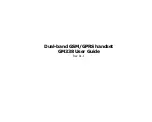
9600 Series IP Deskphones installation
34
SIP Deskphones Release 6.4 Installation and Maintenance Guide
transferred to the application installed in the Application File System. Note that the processes in
the Kernel/Root File System do not connect to the network or download files.
The application then connects to the network, obtains any necessary IP address information,
and download files, starting with the upgrade and settings configuration files, and including
Signed Software Packages and other separately downloaded files such as Language Files and
Certificate Files. When a Signed Software Package (which can contain either Kernel and Root
Software Packages or Application and Library Software Packages) is downloaded, it is initially
stored in volatile memory (RAM). Other downloaded files (such as Language Files and
Certificate Files) are installed directly in the Application File System.
When either type of Signed Software Package is downloaded, the Signing Authority Certificate
is extracted from the package and is validated using a copy of the Avaya Product Root
Certificate Authority Certificate that is contained in the existing application software files. If the
Signing Authority Certificate is invalid, the package is deleted. If the Signing Authority Certificate
is valid, the Hardware Version File in the package is validated using the corresponding
Signature File in the package and the Signing Authority Certificate. If the signature is invalid, the
package is deleted. If the signature is valid, the Hardware Version File is used to validate
whether the package is valid for the model and hardware version of the deskphone. If it is
invalid, the package is deleted. If it is valid, the signature of the Software Packages is validated
using the corresponding Signature Files in the package and the Signing Authority Certificate. If
either signature is invalid, the package is deleted.
If the signatures are valid and the Signed Software Package is a Signed Application/Library
Software Package, the package is stored in Temporary Storage. If the Backup Flag is set in the
Hardware Version File, a copy of the Signed Application / Library Software Package is also
stored as the Backup Package, replacing the previous Backup Package.
If the signatures are valid and the Signed Software Package is a Signed Kernel/Root Software
Package, the Kernel Software Package and/or the Root File System Software Package is
installed if either has a different file name than the currently installed version, replacing the
existing corresponding files in the Kernel/Root File System that was not active during startup (a
Root File System Software Package may also install new boot programs in the boot program
area), that Kernel/Root File System is marked as the one to be activated after the next
power-up or reset, and the value of the persistent parameter RFSINUSE is set to the file name
of the Signed Kernel/Root Software Package that was installed.
Finally, if a new Signed Kernel/Root Software Package was installed, the deskphone will reset
to activate the new Kernel/Root File System, which will install a new Signed Application/Library
Software Package as described above if one has been stored in Temporary Storage. If a new
signed Kernel/Root Software Package was not installed, the deskphone application attempts to
register with a call server.
Summary of Contents for one-X 9611G
Page 4: ......
Page 7: ...Contents Issue 5 August 2014 7 Appendix A Glossary 85 Index 89 ...
Page 8: ...Contents 8 SIP Deskphones Release 6 4 Installation and Maintenance Guide ...
Page 20: ...Introduction 20 SIP Deskphones Release 6 4 Installation and Maintenance Guide ...
Page 66: ...Local administrative options 66 SIP Deskphones Release 6 4 Installation and Maintenance Guide ...
Page 88: ...Glossary 88 SIP Deskphones Release 6 4 Installation and Maintenance Guide ...
















































